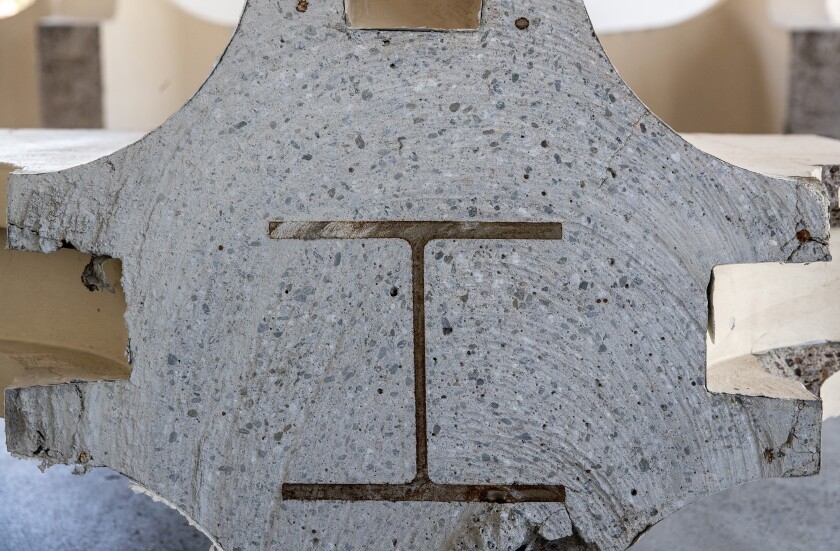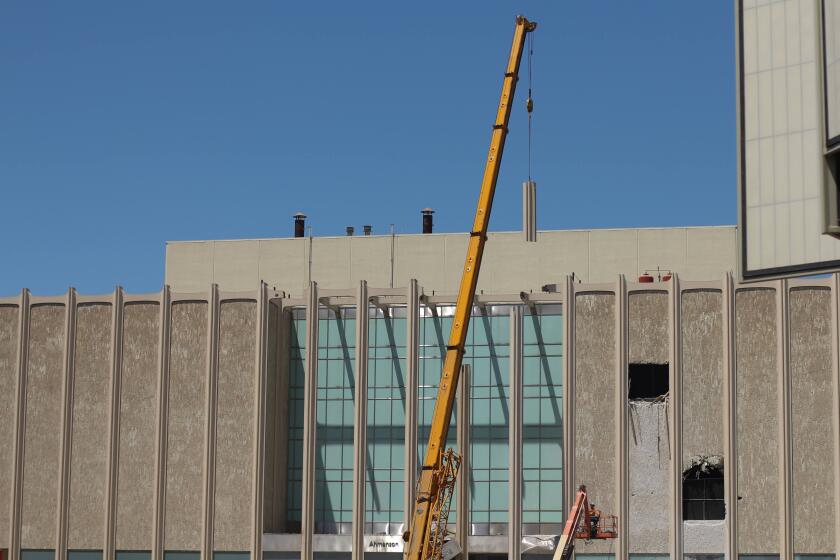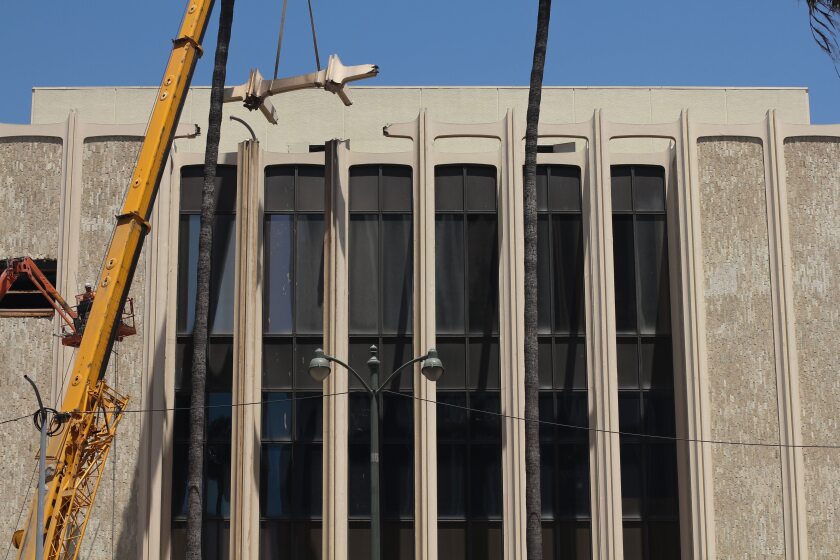When the Los Angeles County Museum of Art demolished much of its east campus last summer to make way for a new design by Swiss architect Peter Zumthor, it seemed to spell the end of an era for the museum.
Gone forever were the trio of Modernist buildings designed by William L. Pereira & Associates — the so-called Temple on the Tar Pits — structures that were so emblematic of Los Angeles, they not only functioned as civic markers but also made appearances in iconic works of art. Ed Ruscha torched them in his 1965-68 painting “Los Angeles County Museum on Fire” and the collective Asco tagged them up in their infamous “Spraypaint LACMA,” from 1972, thereby transforming the museum into a giant work of Chicano art.

LACMA in the midst of demolition in August 2020. The Ahmanson building at center was all that remained of the Pereira-designed structures at that point.
(Mel Melcon / Los Angeles Times)
Except the buildings are not gone forever. Fragments have survived.
These will be at the heart of a new public pocket park, being planned just south of the Pacific Design Center, that was approved by West Hollywood’s City Council last week. The proposed installation is the work of Cayetano Ferrer, a Los Angeles-based artist who has long had an interest in the ways in which issues of design and memory intersect. It is being executed in collaboration with landscape architect Bron Ruf.
Ferrer acknowledges that working with fragments of a building whose demolition was loudly contested and for which many Angelenos felt a deep nostalgia is a loaded thing.
“The first reaction I was getting is, ‘Why would you want to preserve such a mediocre building?’” he says, as he picks his way through the Pasadena storefront where he has assembled the fragments. “But that’s not what this is about.”

The cross-section of a William Pereira-designed column, with its I-beam visible, is displayed in a storefront in Pasadena.
(Brian van der Brug / Los Angeles Times)
Ferrer is more interested in how the fragments might function as contemporary ruin — in much the same way that some public spaces in Italy might contain a toppled Roman column or the remnants of entablatures, and that these might be employed in unforeseen ways, be it as furniture or an improvised playground.
The artist also is interested in how these fragments might provide a relatively new city — much of Los Angeles was built during the 20th century — with a palpable, visual layer of its history. “That’s really the most important part of this,” he says. “This is a very privatized city and there aren’t a lot of spaces like public plazas where that might occur, where the past might be layered upon.”

Cayetano Ferrer stands with remnants of the now-demolished LACMA buildings.
(Brian van der Brug / Los Angeles Times)
Naturally, he is toying with notions of authenticity as well, since the proposed site, at the corner of Melrose Avenue and Norwich Drive, is almost 2 ½ miles from LACMA. But that ersatz condition should be perfectly familiar in a city like Los Angeles, where Victorian houses are moved around like pawns by developers and not even the Angels Flight funicular is in its original location.
On Saturday, Ferrer will be exhibiting the fragments in a one-day show in Pasadena, organized in collaboration with his gallery, Commonwealth and Council. In this conversation (which has been edited for length and clarity), he talks about why context is everything and how he came to be in possession of several thousand pounds of LACMA’s façade:
I’d like to start with the fragments. How did you get them?
I was doing a project with the Art + Tech Lab [in 2015] at LACMA. The concept of the project was to really look through the fragmentary objects the museum has — whatever the conservators could bring me. I was scanning them to get closer to the object and understand it better. That project, ostensibly, was part of a larger research project into the practices of restoration. There are so many museums that have objects that have been wrongly restored.

A construction crane removes a fragment of the columned façade from LACMA’s Ahmanson building last summer.
(Cayetano Ferrer)
I’m looking at all of these fragments as the news was becoming clear that the building I was doing this work in was going to get demolished. That really got me thinking about the systems of value in museums. Who chooses what is important? What does that mean about the way we build here? I found it interesting that the museum would demolish itself and not preserve any of it — even though they preserve other fragments.
So, I basically approached a handful of people who I had contact with through the Art + Tech program. [My project is] not a LACMA project but they helped me get in touch with the contractors and were OK with giving them whatever pauses they would need to take fragments. But that was very limited because they were like, “We are tearing this down and we need to stay on schedule.”
How did that then become part of this park proposal in West Hollywood?
I’ve worked in this method of creating absurd, impossible proposals of, “Oh, what would it look like to do this?” So I did the math [on the building’s columns] and figured out that if you took these pieces they would be almost bench height. And what if you took a piece and put it in the city? And what if you wouldn’t call it a bench but instead people would create their own meaning for it?

Concrete columns that once were part of LACMA’s Ahmanson Building will go on display in a one-day show in Pasadena on Saturday.
(Brian van der Brug / Los Angeles Times)
[Los Angeles is] a city that doesn’t retain much of its past in the way other older cities have, just by nature of the fact that most of it is built with concrete and it is sort of perceived as disposable. There is so much to be said with ruins and the obsession with ruins. There is this whole field of folly ruins and re-creations of these sites.
At some point, a team — Jody Rassell and Nancy Gamboa [art advisors contracted by the city] — got in touch about proposing something for this project in West Hollywood. I was like, I’ve never done public art before, but I do have this crazy idea. And it all lined up.
Your pile of impossible proposals included a structure embedded with fragments of the 6th Street Bridge. How far did you get on that?
The project was for the façade of a building that is now near the 6th Street Bridge. I had this idea to embed [fragments of the bridge] into this building. The request for proposal was asking for something that would treat the surface. I think they were thinking along the lines of a mural.
But the budget was quite generous, so my idea was to take these light poles and columns [from the bridge] and embed these and other objects into niches along the building’s façade. It was really about a confrontation with architecture — an intervention into the structure of the building, to use it as a display device.
No. I contacted the demolition team and got into pretty developed discussions with city engineers. That’s what made it feel possible to do something like this. But it just existed as a concept.
Pereira’s LACMA design has not been viewed kindly by critics. Historians David Gebhard and Robert Winter pointedly did not include it in their first “Architectural Guidebook to Los Angeles.” And in the most recent edition, they write that the design “was (and is) dull.” Beyond the concept, what makes these fragments — the columns from the façade — interesting to you?
These are some of the elements that project off the building, so it made this an elegant separation process. It made the most intrinsic sculptural sense. It was about streamlining the process and streamlining the idea. And it was important to not just get the the columns but the crown from the top. If you look at the building, it is one of the more distinguishing parts of it. There is a lot of geometry and it feels related to the period.

Among the fragments that Cayetano Ferrer extracted from LACMA are the pieces that joined the building’s columns — evocative of midcentury design.
(Cayetano Ferrer)
There is a subtle humor to it. It’s playing with all of those heated debates about how valuable this architecture is or not. That doesn’t matter to me. It’s important to me that we all know what it is.
From the photographs you took during demolition, it’s clear that you didn’t just wade into the rubble for a few pieces. The removals look surgical.
Almost as important as the final product is that I was thinking about how this would look through different stages. I saw [the removals], for a brief moment, as a sculpture in negative space in the museum. I’ve been working on this for two to three years and there are times where the project is about that moment.

For “Extraction,” Cayetano Ferrer sliced out pieces of the LACMA façade in ways that made what he removed as sculptural as what was left behind.
(Cayetano Ferrer)
The overall title is “Extraction.” There is “Extraction I” [the removal of fragments from the site], “Extraction II” [the display of the fragments that will take place on Saturday] and “Extraction III” [the final installation in West Hollywood].
It’s this relationship to archeology, the site as an archeological site. It’s kind of playing through the story of the site in a way: the relationship these have to bones that have been dug up, the extraction of resources, the larger story of colonization. The infrastructure of the encyclopedic museum is built on the grand tour of the 1800s and literally extracting. That process is how these institutions were developed as a cultural form. As an artist, I’m reversing that process onto the architecture.
You did another piece involving fragments. In 2015, you created an installation for the Santa Barbara Art Museum titled “Interventions,” in which you paired pieces of ancient ruins with a patchwork of casino carpets. How do those connect?
That museum’s architecture is a very strange hybrid of Neoclassicism. Some is part of the original post office building and there is a more recent sort of Postmodern addition that has these Neoclassical features. If you think of that as a frame for their collection, it’s kind of a strange design. It’s a fantasy.
It’s not that different than walking into a casino. There is almost an honesty in the illusion of casinos that I think we forget when we are walking into a cultural institution. Sure, it is tethered to science and research — I don’t want to downplay the work that museums do; I love museums — but how you contextualize certain objects, especially objects from a different place, they affect how those objects are perceived.

Cayetano Ferrer’s “Interventions” at the Santa Barbara Museum of Art in 2015, contrasting garish casino carpets with architectural fragments from ancient ruins, was organized by curator Julie Joyce.
(Santa Barbara Museum of Art)
So that show was designed to give you the sense that we are not in a temple, we are not in a Greek space. And I wanted to highlight that in a rather outrageous way.
Some of those casino carpets, ironically, bear elements of Classical patterns.
That carpet is about disrupting continuity. It’s simultaneously giving you references to these different places, but you’re breaking the unified period space. It breaks your sense of time. You could put anything in there and it would have some relationship to these clip-art graphic casino carpets.
As someone who has spent a lot of time thinking about LACMA, what’s your view of architect Peter Zumthor’s design for the new building?
There are things coming out of the dialogue about why this change [which will reimagine the ways in which permanent collections are shown] was necessary, which is that you have to move on from the notion of the encyclopedic museum. I don’t know how you move on from that when you have that collection. How do you deal with those legacies? Changing the architecture can be a really important step to rearranging how you do things.
It’s laudable. But I’m waiting to see on the Zumthor. I will personally reserve judgment until I see it.
“Cayetano Ferrer: Fragments for the Los Angeles County Folly Ruin”
Where: 1870 E. Walnut St., Pasadena
When: Saturday, 4 to 7 p.m.
Admission: Free with RSVP at [email protected]
appId : '134435029966155',
xfbml : true, version : 'v2.9' }); };
(function(d, s, id){ var js, fjs = d.getElementsByTagName(s)[0]; if (d.getElementById(id)) {return;} js = d.createElement(s); js.id = id; js.src = "https://connect.facebook.net/en_US/sdk.js"; fjs.parentNode.insertBefore(js, fjs); }(document, 'script', 'facebook-jssdk'));
Stay connected with us on social media platform for instant update click here to join our Twitter, & Facebook
We are now on Telegram. Click here to join our channel (@TechiUpdate) and stay updated with the latest Technology headlines.
For all the latest Entertainment News Click Here
For the latest news and updates, follow us on Google News.
